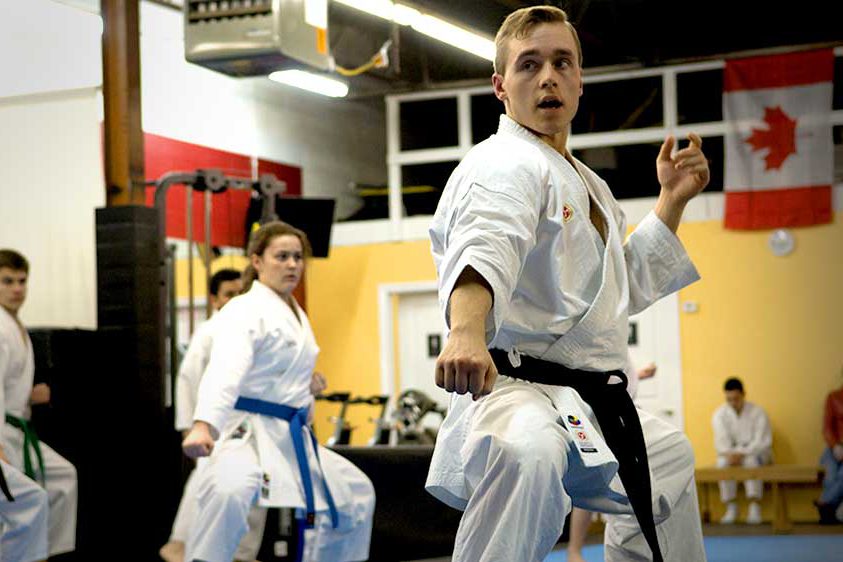Question: Do you consider yourself a martial artist?
I mean really, a martial artist; somebody who literally expresses his art through martial motions.
Do you?
Well, if you do, and you regularly tell people that you practise a martial art (like Karate), then I sincerely hope you take your art seriously enough to consider the powerful message contained in its stillness.
You see – to make a long story short – there exists a heated debate in Karate about a) whether or not one should have pauses in the performance of a kata, and b) exactly how long, and where, these pauses should be.
In short: Many people have a hard time grasping pauses in kata.
And some people get really angry about this.

Indeed, a quick look at almost any of my popular YouTube videos of kata will most likely reveal a flaming comment section, with self-proclaimed keyboard warriors arguing back and forth whether some kata performer’s pauses are too long or not.
This, ladies and gentlemen – is absolutely ridiculous.
If you are one of these “kata pause bashers”, I need you to seriously reconsider your approach to Karate in general, and kata in particular.
What am I talking about?
Allow me to explain:
First of all, sure, in a real fight (a ‘balls-to-the-wall’ self-defense situation), there is no need for pausing at all. That’s just insane. Unless you have a godly amount of testicular fortitude, the sensible thing is to always finish your opponent as quickly as possible and then effectively make your escape to safety.
Obviously.
But that’s not what we’re talking about here.
Because the performance of a kata is NOT a fight.
(The bunkai, however, is.)
The performance of kata is a visual manifestation of various solo-applications (sequences of offensive and defensive self-defense techniques) used in a fight, strung together into a geometrical pattern, expressed through, and cultivated by, a performer to such a degree that the whole ultimately becomes greater than the sum total of its individual parts.
And when that’s skillfully done, onlookers get goosebumps.
Just like any art.
But in order to achieve this level of performance yourself, you need to master stillness.
Because pauses speak louder than movements.
“The most precious things in speech are the pauses.”
– Sir Ralph Richardson (1902-1983)
Why?
Well, in short, the power of pauses lies in the fact that they make us powerfully aware of what has been suspended.
And as such, they are crucial to the emotional and visual impact of the performance of your kata.
But that’s not all – pauses work in more ways: As a comparison, in printed text for example, punctuation is used to separate words, right? The varying punctuation marks (period, comma, dash etc.) give information about how we should read and comprehend the words. Punctuation arranges the words in parcels, separating one unit from the next, so we can easily unwrap/decode them one at a time. In other words, punctuation allows us to make sequential sense of the material – just like in all forms of artistry: In music there’s many kinds of pauses (fermata, lunga pausa, caesura etc.), and in photography or painting the key to great shots is working with the negative space.
But you’re not stupid.

You know that Karate isn’t literature, music, painting or photography… and a kata isn’t a song or an essay.
But it still works in the
- exact
- same
- way.
In stillness, the emotional impact of your movements flower to their full potential.
When you punch and kick, you only seed the techniques. It is in the pause where they actually grow.
In Karate, the skillful use of pauses make all the difference.
And that holds true for life as well.
I mean, we think that when we pause – no matter if it’s a brief break in a kata or a week-long holiday retreat in our ‘regular’ busy life – we are losing time that could be used productively. We think we’re always making progress when we’re in motion, moving forward on our way to our goals… while in reality it’s often when we pause that the most progress is actually made.
It’s common wisdom that discoveries and insights come when we stop working on something and let it go for a moment.
Because in life’s pauses we find the silent background of our being.
(And not too many people are comfortable with this…)

Inspiration and ideas spring from deep within. They can’t be reached through mental focus, thinking or logic. They are accessed when the mind is relaxed and flowing. Hence, pauses refresh and renew, and in that way actually contribute to our productivity, while bringing balance and an enjoyable rhythm to life.
I mean, we can’t live at all without the long pause of sleep or even the tiny pauses of breath, right?
Pauses give life.
In the exact same way, pauses make your kata live too.
In music, it’s the pauses that make the rhythm. It’s in the pauses that the notes truly settle in and have time to reverberate in our hearts.
The same holds true for Karate.
At least if you call yourself a martial artist.
Karate, to me, is a martial art no less sophisticated than other forms of human art (we just happen to be great at self-defense too). In that context, I seriously believe the performance of kata to be the pinnacle of sophistication when it comes to Karate’s various means of artistical output, and I believe one should always strive to embrace a kata wholeheartedly in the martial as well as the artistic sense – complete with pauses and everything.
Silence is a gift.
Use it effectively, and it will speak louder than your actions.
In Karate, as well as life.
And that, my friends, is the true power of pauses.



77 Comments